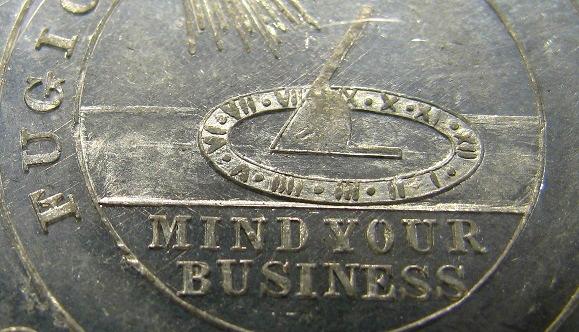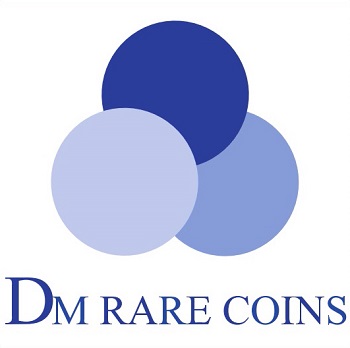You are reading an original DM Rare Coins Research Article. Find More!
September 24, 2018
Thin Planchet 1876 Dickeson Continental Currency Dollar Discovered:
Possible Die Trial HK-854 Changes the Standards for Identification

We are announcing the discovery of an original 1876 Dickeson Continental Currency Dollar Copy, HK-854, struck in white metal, but on an uncharacteristically thin, 2mm planchet. The Hibler-Kapen, So-Called Dollars book, and other references, have long stated that all original HK-854 medals were struck on planchets ranging from 3.0 to 3.4 mm in thickness. The early die state confirms our piece is an original, and measuring just about 2.0 mm thick, these previous assumptions are no longer accurate. We believe this to be a previously undocumented, 1876 Trial Strike from Dickeson’s coiner, and that other thin planchet pieces likely exist.
Our first reaction, after hearing of this piece, was to assume it is not really a Dickeson original, but rather some sort of Thomas Elder creation from 1917, or even a Bowers Restrike of 1961-1962. However, both of these theories fall flat upon seeing the actual medal. First, while Thomas Elder various pieces are often thinner than Dickeson’s, Elder is not known to have used Dickeson Continental Currency reverse die. In fact, it is unclear whether or not Elder even owned the reverse die, as his various issues all use the obverse, paired with some other reverse. Furthermore, and more importantly, all issues attributed to Elder show an advanced die state of the obverse. The dies were in bad shape by 1917; with a jagged die break near the C in CONTINENTAL; traces of die clashing around the sundial; a die scratch across the left side of the table; and heavily polished, unnaturally glossy surfaces. Elder’s pieces also show considerably less definition on the wood grain of the table, and a broken upper-left table edge. None of these many die markers are seen on our early die state medal.
Post-Dickeson Uses of the Obverse Die
ThisHK-860 uses a refinished stage of Dickeson's obverse die. NGC currently attributes this issue to Thomas Elder.* This brilliant piece is from freshly polished dies, with noticeably weak table details. All post-Dickeson strikes show: glossy surfaces, die clashing on right side of sundial, die break through circle above C, and die scratch on left side of table (the latter disappears on Bashlow Restrikes).
*Note: NGC currently attributes all post-Dickeson issues to Elder. It is possible some where made after Dickeson but prior to Elder. See our related article for more information: "Distingishing Dickeson's Dollars: 1876 Continental Currency Dollar Imposters."
Additionally, the Bowers Restrikes; produced in England in the early 1960s for David Bowers's Empire Coin Company; were struck from faithfully reproduced transfer copy dies. They show all the original defects of Dickeson’s dies, in addition to a few new defects that are unique to the transfer copies. The most well-documented of these is a die scratch between the rim and the O in CONTINENTAL. Of course, none of these anomalies appear on our piece, as it is from an early stage of the original dies. Also, the Bowers Restrike dies were deeply polished, with high-gloss, mirrored surfaces. Empire Coin Company intended and referred to them as Proofs in their advertisements. While technically, they are not Proofs, many will qualify for a Prooflike designation, and a select few are even Deep Mirror Prooflike. Importantly, the Bowers issues were all struck on uniformly machined, 2.5mm thick planchets; too thick to mix up with our discovery piece. And, if Thomas Elder’s 1917 issues showed weakened definition, the Bowers Restrikes show almost no definition on the table, as well as a thinner rim and smaller, more separated beading. Interestingly, some of the early strikes of the Bowers issue show just a suggestion of light Cameo contrast at certain angles, likely added back in with either acid etching or light sandblasting of the high points of the copy dies. That said, there is no comparison with our early die state original.
In sharp contrast to these various later issues, inspection of our thin planchet find reveals a much earlier strike from new, 1876 dies. The engraving is fresh and crisp, and the frost over the Cameo devices is heavy, thick, and clean. Also, the fields show the unmistakable orange peel-textured mirrors found on freshly created dies, typical of so many other vintage, 1860s-1870s era tokens and medals. This is in contrast to the high-gloss, refinished surfaces of the various restrikes. The edge of this thin planchet almost looks rough hewn and is distinctly 19th Century, as it was filed down to size prior to striking. Compare this to the smoothly machine punched edges of the standard 2.5 mm Bowers Restrikes.
Not only is this piece from the original dies, it is one of the earliest die states we have been able to document. It is a substantially fresher die state than seen on the copper HK-853 in PCGS MS65, used extensively in our related article. That copper piece is over 3mm thick and unquestionably an 1876 original. Yet, the engraving on it is slightly less distinct than our thin HK-854, due to mild die wear. In particular, the fine details of the table top are slightly less crisp. Likewise, the Cameo contrast is gone from the 853, as are the mirrored, Prooflike surfaces.
It is interesting to note that NGC has graded 11 Prooflike HK-854 pieces; or roughly half the total certified population; but that none of the Copper HK-853s have graded PL. This suggests that the Copper medals were struck after the White Metal pieces. That said, there is quite a gap in die state, between the PL stage of our Thin Planchet HK-854, and the later stage seen on our HK-853. This variance suggests that many more pieces were struck in white metal than are currently known to survive today. This helps explain why our discovery piece has only recently turned up, and also why it should not be surprising to learn that more variations are potentially out there.
All things considered, the evidence points to this Thin Planchet discover piece being an early die state of Dickeson’s original issue. Perhaps it was put more succinctly by renowned medals dealer, Richard Gross, who exclaimed, “You have a Dickeson! There is nothing quite like the original,” when he examined pictures of this discovery piece.
Ok; so we have a Dickeson, but why is it only 2mm thick? Being that it is an early die state, we surmise it could have been an experimental strike or a Die Trial, used to test the design and equipment. The planchet of our piece appears to be slightly wavy, as are many of the mid-19th Century tokens, which were similarly thin and would often buckle under the pressure needed to strike up the design. On a dollar-sized piece that is made too thin, one also runs a greater risk of not striking up the design properly, and there is some minor roughness caused by metal flow issues. Testing various thicknesses, Dickeson’s coiner most likely saw the result of using a thin planchet very quickly, and decided to go thicker, and thicker, with the planchet stock. Perhaps most of the thinner pieces were destroyed at the time, explaining both their pronounced rarity and also how they remained unnoticed, until now.
While this is a new discovery and presumably quite rare, its existence should not come as a surprise. In the process of researching the Dickeson issues, we found planchet irregularities to be the norm. Until now, the White Metal, HK-854 pieces were known to range from 3 to about 3.4 mm in thickness, and the Copper, HK-853s can range anywhere from 3mm to 6mm thick, based on what was offered by Stacks in the Ford sale. Why not presume a 2 mm planchet could also exist for the HK-854. It does.
In actuality, we know very little, with certainty, about the production standards of Dickeson’s coiner. The state of the dies between striking the HK-854s and HK-853s seems to corroborate the original mintage guesstimates given by Bowers, of "a few hundred" and "a few dozen," respectively; but today, these medals are R6 and R7 (Bowers, 307). NGC has graded just 21 HK-854s and even fewer HK-853s. The number of both compositions, certified at PCGS, can be counted on one hand. If hundreds were made, there are clearly many coins missing, and because our collective understanding of these issues is based only on the small quantity of known survivors, there are likely still things we can learn about these medals.
More examples are surfacing as time goes by. Who knows how limited the availability was when Hibler and Kappen published their thickness standards, decades ago. It may even be the case that more of these are going under the radar because they are not thick enough to match the HK descriptions. The present specimen is no more than 2mm thick, but it is clearly an original HK-854 Dickeson Continental Currency Dollar Copy of 1876. No reference guides, just our own extensive research, ultimately put us in front of this rare piece. Keep your own eyes peeled; more anomalies are out there.
Bibliography
Hibler, Harold E.; Kappen, Charles V. So-Called Dollars: An Illustrated Standard Catalog. Tom Hoffman, Dave Hayes, Jonathan Brecher, John Dean Ed. Clifton, NJ: Coin & Currency Institute. Kindle Edition. 1963, 2008. P 164
Bowers, Q. David. Whitman Encyclopedia of Colonial and Early American Coins: The Only Authoritative Reference on All Pre-Federal Coinage. Atlanta; Whitman Publishing, LLC. 2009. P 238, 307.
Special thanks to Heritage for permission to use their images of HK-860.
